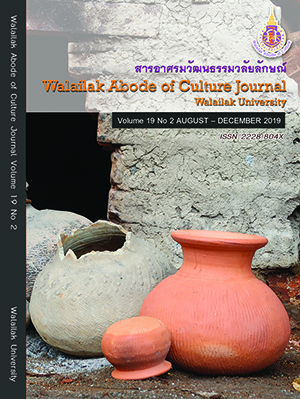Verses of Beauty Admiration: The Exquisite Literary Arts and Love-Scene Transitions Between Pra Lo, Pra Puen, and Pra Paeng
Main Article Content
Abstract
The verses of beauty admiration identified in Lilit Pra Lo play a vital role in the storyline. They are comparable to the critical causes originating various events planned by the author for story transitions. the discourses of beauty admiration were extremely crucial to the story as they stimulated the sexual desires that led all the characters to a catastrophe. Only if Pra Lo were less beautiful, it would not have lured Pra Puen and Pra Paeng into a trap of lust with such strong magnitude of obsession desiring to make him a husband and trying to trick him to travel to meet them both. The above statements reflect the fact that the author intentionally created a leading male character, Pra Lo, to feature an exquisite beauty. It can be further implied that the author attempted to inform the audience that Pra Lo and his beauty is the vital essence of the story. To emphasize that he is the most beautiful person in the three worlds, the author wrote 9 Klong Song and 1 Rai beauty-admiring verses for it which is an excessively lengthy and unusual narration for a topic.
Article Details
© 2018 by Asian Journal of Arts and Culture, Walailak University. All rights reserved.
References
Chittasopot, A. (1996). Kansueksa Wikhro Charit Niyom Thang Wannakam Thai. Krungthep, Thailand: Ton O Kraem Mi Chamkat.
Kromsinlapakon. (1974). Lilit Phra Lo (Phim Khrang Thi 15). Krungthep, Thailand:
Khlang Witthaya.
Prachakun, N. (2009). Wathakam Thamhet Nai Lilit Phra Lo. In Yok Akson Yon Khwamkhit, 1.
Krungthep, Thailand: An.
Ruengraklikhit, C. (2001). Aan Lilit Phra Lo: Chabap Wikhro Lae Thotkhwam. Krungthep, Thailand: Samnak Phim Chulalongkonmahawittayalai.
Ruengraklikhit, C. (2006). Kan Chom Khwam Ngam Khong Nang Nai Wannakhadi. Ruam Botkhwam Wichai Lae Botkhwam Wichakan Phasa Lae Wannakhadi Thai.. Krungthep, Thailand: Khrongkan Phoeiphrae Phonngan Thang Wichakan Khana Aksonsat Chulalongkonmahawittayalai.


